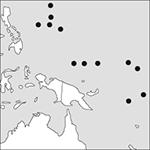
Source: MAPS IN MINUTES™ © RH Publications (1997)
Capital:
Palikir (on Pohnpei)
Area:
702 sq km (271 sq miles)
Population:
106,104 (2013 est)
Currency:
1 US dollar=100 cents
Religions:
Roman Catholic 52.7%; Protestant 41.7%
Ethnic Groups:
Chuukese 48.8%; Pohnpeian 24.2%; Kosraean 6.2%; Yapese 5.2%
Languages:
English (official); Micronesian languages
International Organizations:
UN
A country in the west Pacific Ocean, comprising a group of islands divided into four states: Yap, Chuuk (formerly Truk), Pohnpei (formerly Ponape), and Kosrae.
Physical
The Federated States of Micronesia forms part of the Caroline Islands group, one of the archipelagos east of the Philippines. The islands are low coral caps surmounting submerged extinct volcanoes. The climate is tropical, and the area is prone to typhoons.
Economy
Economic activity is dominated by the government, which employs two-thirds of the labour force and is funded largely by US aid. Other principle activities are subsistence farming and fishing, with the main exports including fish, clothing, bananas, and black pepper. There is some tourism.
History
The first settlers on the islands were probably Melanesians who arrived in about 1500 bc. Micronesia was colonized by Spain in the 17th century and was sold to Germany in 1898. The islands were occupied by Japan from 1914 until their capture by American forces in 1944. In 1947 Micronesia became part of the UN Trust Territory of the Pacific Islands, administered by the USA. From 1965 there were increasing demands for autonomy and Micronesia became independent in 1979. The US administration was not formally ended until 1986 and was not ratified by the UN until 1990. A compact of free association was signed with the USA in 1982, giving the USA responsibility for Micronesia’s defence.
- systematic risk
- systematics
- systematic sampling
- system box
- system building tools
- system bus
- system crash
- system definition
- system design
- system development
- system dictionary
- system generation
- systemic acquired resistance
- systemic arch
- systemic circulation
- systemic grammar
- systemic risk
- systemic signalling
- systemic threat
- system identification
- system life cycle
- system log
- system modelling
- system of logic
- system of particles